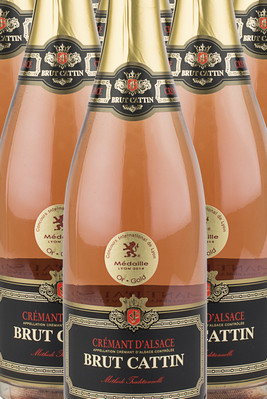 Cattin Crémant d’alsace rosé-Sustainable
Cattin Crémant d’alsace rosé-Sustainable
The Cattin family, of Swiss descent, can trace their arrival in Alsace to around the year 1720. The family settled in the village of Voegtlinshoffen 10km south of the Alsatian wine capital of Colmar. Being that the region had been famous for its wines since the Middle Ages they immediately planted vines and began the viticultural legacy that continues today. The Domain is named for Joseph Cattin who became renowned for his pioneering work in grafting that, at the end of the 19th century, is widely credited for saving some of Alsace’s best vineyards from phylloxera.
Today the Estate is run by Jacques and Jean-Marie Cattin as well as the latest generation, represented by Jacques Jr. They own 50 hectares of vines planted to all the traditional Alsatian varietals and have two separate wineries, one of which is dedicated solely to the production of their incredible crémant wines. The vines are located in the prestigious Upper Rhine and are planted on the mostly SE facing slopes at the base of the Vosges Mountains ranging from 200-400 meters in altitude. The soils vary considerably from compositions of gravel, granite, marl to clay, limestone and sandstone. Most of the Cattin estate vineyards are over 60 years old.
The estate is composed of many small plots located in the southern part of the Colmar region and a staggering 80% of their vineyard land is located on slopes. A broad menu of soils (clay, limestone, sandstone, ferruginous, marl…), combined with big-time diurnal shifts, means an exceptional palate of aromas and flavors.
Cattin uses large old oak foudres to produce some of the region’s most terroir-driven Grand Cru wines such as the legendary Hatschbourg which ranks among the family’s oldest plots.
Over the past several decades, their Crémants have become the house specialty.
100% Pinot Noir – grapes are handpicked. Short maceration to extract the pale salmon color and gentle pressing of the grapes. The first fermentation happens between 64°F and 72°F. The second fermentation happens in bottle (méthode champenoise), and is followed by 15 months of aging on the lees before disgorgement.
A clear and elegant pale salmon color with numerous fine bubbles. The nose is deliciously fruity with notes of freshly squeezed strawberries and raspberries. The palate is refreshing and creamy with fruity aromas such as strawberries and lemon. A clean and long-lasting finish.
90 points, Wine Enthusiast: Rounded, balanced, and harmonious flavors get top marks on this softly pink sparkler. Strawberries and cream, with shortbread and lemon, all unite in perfect unison. The dryness of the palate gives the flavors center stage and provides a fitting, structured autolytic background. This sparkler is classy and delicious, with an ultra clean and lasting finish.

